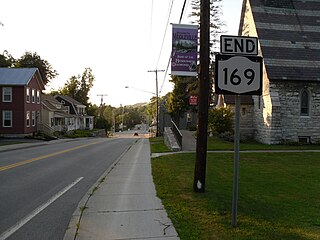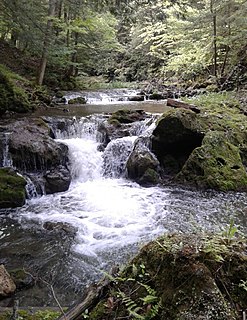
Danube is a town in Herkimer County, New York, United States. The population was 1,039 at the 2010 census. Early Palatine German immigrants in the eighteenth century named the town after the Danube River in Europe.

Fairfield is a town in Herkimer County, New York, United States. The population was 1,627 at the 2010 census. The town is named after Fairfield, Connecticut.

German Flatts is a town in Herkimer County, New York, United States. The population was 13,258 at the 2010 census.

Middleville is a village in Herkimer County, New York, New York. The population was 512 at the 2010 census.

Winfield is a town in Herkimer County, New York, United States. The population was 2,086 at the 2010 census. The town is named after General Winfield Scott and is in the southwest corner of the county, south of Utica.

Frankfort is a town in Herkimer County, New York, United States. The town is named after one of its earliest settlers, Lawrence (Lewis) Frank. The town of Frankfort includes a village, also called Frankfort. Frankfort is located east of Utica, and the Erie Canal passes along its north border. At the time of the 2010 census, the population was 7,636.

Herkimer is a village on the north side of the Mohawk River and the county seat of Herkimer County, New York, United States, about 15 miles (24 km) southeast of Utica. As of the 2010 census, it had a population of 7,743. It was part of the Burnetsfield Patent and the first European-American settlement this far west in the Mohawk Valley.

Herkimer is a town in Herkimer County, New York, United States, southeast of Utica. It is named after Nicholas Herkimer. The population was 10,175 at the 2010 census.

The Mohawk Valley region of the U.S. state of New York is the area surrounding the Mohawk River, sandwiched between the Adirondack Mountains and Catskill Mountains. As of the 2010 United States Census, the region's counties have a combined population of 622,133 people. In addition to the Mohawk River valley, the region contains portions of other major watersheds such as the Susquehanna River.

The Battle of Oriskany was one of the bloodiest battles in the American Revolutionary War and a significant engagement of the Saratoga campaign. On August 6, 1777, a party of Loyalists and several hundred Indigenous allies across several nations ambushed an American military party that was marching to relieve the siege of Fort Stanwix. This was one of the few battles in which the majority of the participants were Americans; Patriots and allied Oneidas fought against Loyalists and allied Iroquois in the absence of British regular soldiers. There was also a detachment of Hessians in the British force, as well as Western Indians including members of the Mississauga people.

Nicholas Herkimer was an American patriot militia brigadier general during the American Revolutionary War. He died of wounds after the Battle of Oriskany.
New York State Route 28 (NY 28) is a state highway extending for 281.69 miles (453.34 km) in the shape of a "C" between the Hudson Valley city of Kingston and southern Warren County in the U.S. state of New York. Along the way, it intersects several major routes, including Interstate 88 (I-88), U.S. Route 20 (US 20), and the New York State Thruway twice. The southern terminus of NY 28 is at NY 32 in Kingston and the northern terminus is at US 9 in Warrensburg. In Kingston, NY 28 is co-designated as Interstate 587 from its southern terminus at NY 32 to the roundabout linking it to the Thruway (I-87).
Fort Dayton was an American Revolutionary War fort located on the north side of the Mohawk River at West Canada Creek, in what is now Herkimer, New York. A fort had previously been built on the same site during the French and Indian War.

Fort Herkimer was a colonial fort located on the south side of the Mohawk River, opposite the mouth of its tributary West Canada Creek, in German Flatts, New York, United States.

The West Canada Creek is a 76-mile-long (122 km) river in upstate New York, United States. West Canada Creek is an important water way in Hamilton, Oneida, and Herkimer counties, draining the south part of the Adirondack Mountains before emptying into the Mohawk River near the Village of Herkimer. The name "Canada" is derived from an Iroquoian word for "village" (Kanata).
New York State Route 29 (NY 29) is a state highway extending for 94.79 miles (152.55 km) across the eastern portion of the U.S. state of New York. The western terminus of the route is at NY 28 and NY 169 in Middleville, Herkimer County. The eastern terminus of the route is at NY 22 just south of Salem, Washington County. NY 29 also serves the cities of Johnstown and Saratoga Springs and intersects four major north–south roadways: NY 10, NY 30, U.S. Route 9, and U.S. Route 4.

Donald Jerome Mitchell represented New York in the United States House of Representatives from 1973 to 1983.
Johan Jost Herkimer was a Loyalist born in 1732, the second of five sons of Johan Jost Herkimer and Anna Catherine Petri of German Flatts, Province of New York. He was the younger brother of the American Patriot General Nicholas Herkimer.

Otsquago Creek is a river that enters the Mohawk River in Fort Plain, New York. Otsquago is a Mohawk Indian word meaning 'under the bridge,' probably referring to an early bridge of felled trees along the creek, a way of making small bridges. It is also referred to as Otsquage on old maps, which is an Indian word for 'healing waters'.










